2013/03/21
Louis Moinet the Chronograph's Inventor
The recent discovery of a hitherto unknown timepiece is rewriting the history of watch development. It turned out to be the first ever chronograph, although its maker, Louis Moinet, called it a “compteur de tierces.” According to hallmarks on the dust cover, the chronograph was started in 1815 and completed the following year.
This remarkable instrument of an entirely original design is evidently the work of a genius well ahead of his time. It measures events to the sixtieth of a second (known in those days as a “third” or tierce in French), indicated by a central hand. The elapsed seconds and minutes are recorded on separate subdials, and the hours on a 24-hour dial.
The stop, start and reset functions for the central hand are controlled by two buttons which qualifies it as a chronograph in the modern sense, although the term was coined much later. The return-to-zero function was revolutionary for the time. Until today, this invention had been thought to date from Adolphe Nicole’s patent of 1862.
High-frequency pioneer
In the 19th century, watchmakers sought to increase the precision with which they could measure time by increasing the frequency of their watches. By 1820 the generally accepted limit was time measurement to the tenth of a second.
Moinet’s compteur de tierces (“thirds timer”) was thus by far the most precise instrument of its period, measuring time six times more closely than the norm. Moinet’s division of time into sixtieths of a second is another historical achievement that places him among the great contributors to modern watchmaking.
The chronograph’s balance beats at 216,000 vibrations an hour or at the then unimaginable frequency of 30Hz. To put that into perspective, the usual balance frequency in a modern wristwatch is 28,800 v/h or 4Hz. Louis Moinet is thus the father of high-frequency time measurement, although it was not until exactly a century later that a watch was made to beat his record.
Setting the sights on the stars
Moinet made the timer for an astronomical transit instrument, originally mounted for use at sea, that he had adapted to track the movement of heavenly bodies from the land. According to a letter he wrote in 1823, “I came to Paris in 1815 with the sole purpose of devising and making a compteur de tierces. The difficult and seldom attempted realisation of this instrument of a new construction, has achieved my purpose most satisfactorily.”
Why did Moinet need such high frequency? He was timing the passage of stars, planets and even planetary moons. A frequency of 216,000 v/h imparted 60 vibrations a second, thus dividing the second into sixtieths. He made the compteur initially to set the precise distance between the crosshairs in his telescope, as he describes in his 1848 Traité d’Horlogerie: “This invention came to me during my observations in the following circumstances. I had acquired a small mobile quadrant by the famous Borda (maker of the entire circle). This instrument, of excellent English manufacture, was balanced on rubies, and by an ingenious system of counterweights was supposed by its maker to be preserved by its own inertia from the motion of the ship, and to provide at sea observations almost as exact as those obtained on land. But the project was not successful. Having acquired the instrument for another purpose, I added, for terrestrial observations, an azimuth circle graduated in minutes with a vernier by the late Fortin, two intersecting levels, a polished mobile axis and a three-footed stand with levelling screws and a scale etc. However the scope’s narrow field of vision put the reticule lines very close together, and it was to remedy this inconvenience of failing to see a line, that I thought up the compteur de tierces, which worked very well by giving me a precise distance between the reticule lines.” (*)
Moinet’s compteur had to function for at least 24 hours at an energy-hungry frequency to time successive transits of a star. To minimise energy consumption his escapement ran on oiled rubies. He reported that it had worked very well for a prolonged period.
The modest watchmaker
The greatest men are often the most modest and such was Louis Moinet, an academic, who shared his research with fellow horologists, rather than a businessman in pursuit of profit. His peers regarded him as one of the greatest horologists of all time. Monsieur Delmas, vice president of the Paris chronometry society had this to say about him: “He was everywhere, at all the discussions just as when he was president of the chronometry society: precise, clear, indulgent, enlightening and encouraging the weak, giving advice to all without self regard, spreading light without ulterior motive…” (From the Panthéon Biographique Universel, 1853).
Today it’s an honour to pay tribute to a great man whose motto was “The essential thing is never to depart from what is true.”
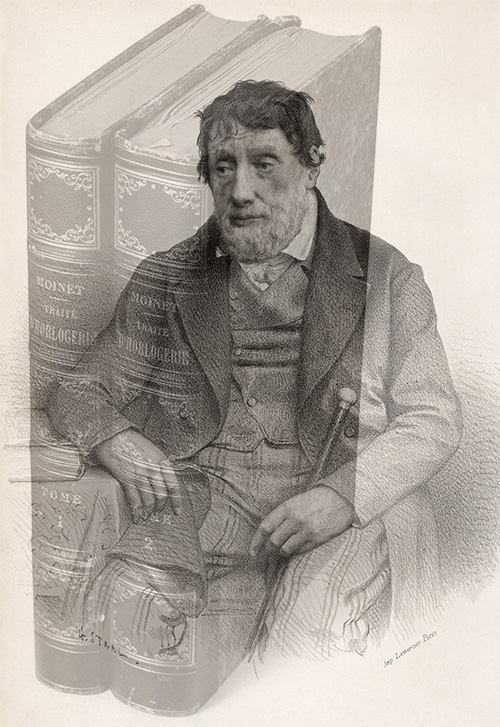
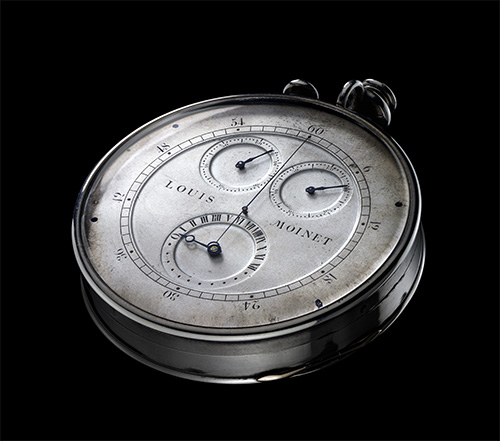
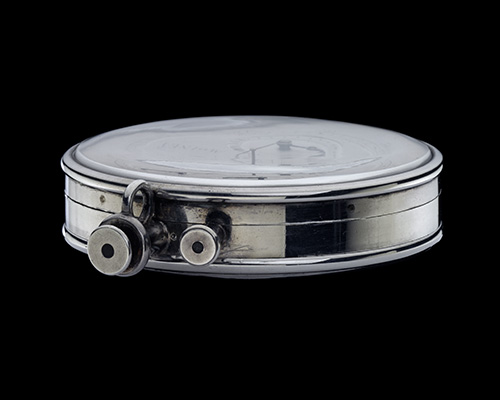
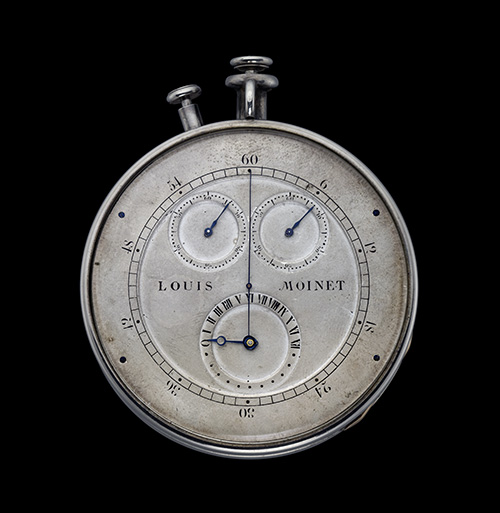

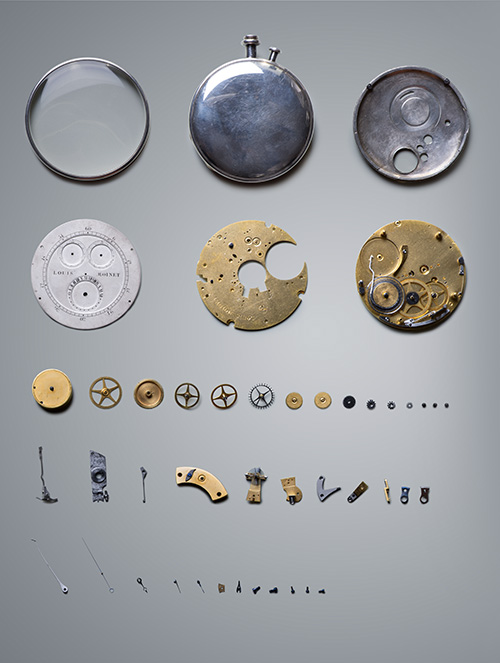
Movement :
- Full plates between four pillars, barrel and fusee
- Ruby and steel cylinder escapement
- Foliot balance with platinum adjustment weights
- 30-tooth escape-wheel
- Flat balance spring with seven coils
- Six pierced ruby bearings with endstones making a total of 13 jewels with the ruby cylinder
- Made in gilt and frosted brass
Frequency : 216,000 vibrations an hour, 30Hz
Dimensions :
- Diameter 57.7mm
- Height: 9mm
- Signed on the upper plate: Louis Moinet
Power reserve :
- More than 30 hours
- State of wind indicator visible through an aperture in the dust cover
Case :
- Silver with a rim around the bezel and caseback
- Bezel with a bayonet fixture
- Hinged dust cover, locked by a threaded stud
- Four-part semi-bassine case with flat caseband
- Four hallmarks on the dust cover: 1. Association des Orfèvres de Paris (goldsmith’s guild); 2. Master’s mark; 3. Second rooster (Ag 900); 4. Guarantee No 815.
Dial :
- Silvered and frosted metal, signed Louis Moinet
- Three subdials on the face:
- Top left : 60-minute counter
- Top right : 60-second counter
- Bottom centre : 24-hour counter
- Top left : 60-minute counter
Hands :
- Slender, counterpoised centre hand for the 60ths of a second
- Two identical hands for the seconds and minutes counters
- An open-tip hand for the hours
- All the hands are in blued steel
- An open-tip hand for the hours
Controls :
- At 12 o'clock: button to start and stop the chronograph
- At 11 o'clock: button to return the 1/60 seconds hand to zero.

